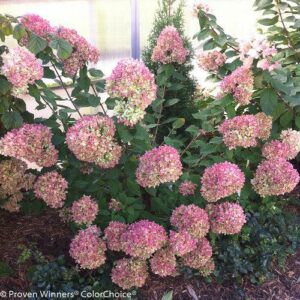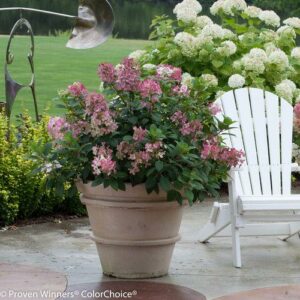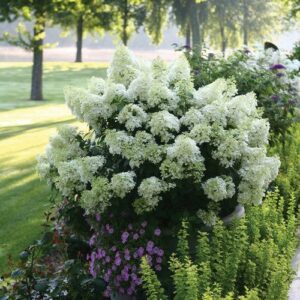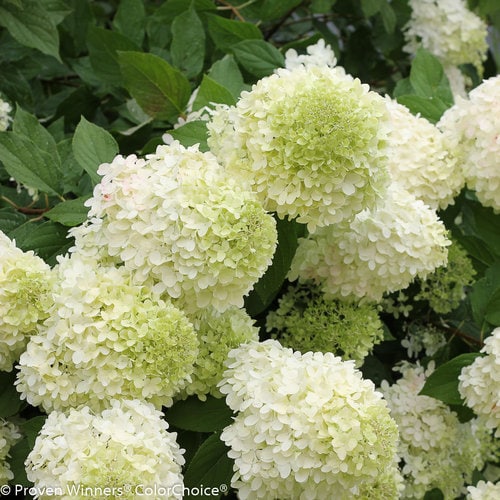‘Limelight’ Hydrangea paniculata. The best-selling panicle hydrangea in history. Photo Credit: Proven Winners
Hydrangeas are easy to grow and maintain and make beautiful additions to your Montgomery, Chester or Berks County, PA landscape. They come in a variety of colors, sizes and shapes. Hydrangeas are deciduous which means they drop their leaves in winter. Some are happy in the sun and others can tolerate more shade.
They once had a bad reputation in that they flopped over and were hard to grow but that has changed over the years with the introduction of many new varieties with huge improvements in stem strength, growth habit, bloom size and color. There’s now a perfect hydrangea for each and every yard.
There are four Hydrangea species that you will commonly find at a nursery:
Bigleaf hydrangeas (Hydrangea macrophylla). Also referred to as Mophead. These shrubs have a rounded habit and typically grow 3-6 feet high, with large, serrated leaves. The long-blooming flowers that appear in summer are either ‘lacecap’ in form, or ‘mophead’, with dense round blooms on top. They bloom on old wood.
*Panicle hydrangeas* (Hydrangea paniculata). Also known as Panicle or Peegee, are considerably larger than bigleaf or smooth hydrangeas, sometimes growing as much 10 feet high if not kept pruned. The flowers bloom in late summer and have a distinctive conical shape, not the round balls seen on other types. These are the easiest to grow and the most winter-hardy hydrangeas. Dwarf panicle hydrangeas are also available.
*Smooth (or Native) Hydrangeas* (Hydrangea arborescens). These are smallish shrubs, rarely growing more than 5 feet high. They have a long bloom period and are similar in appearance to the bigleaf hydrangea, but with smoother textured leaves. Can tolerate more shade. Dwarf panicle hydrangeas are now available.
Oakleaf Hydrangea – (Hydrangea quercifolia). Oakleaf shape leaves and flowers later in season and are suitable for more shady situations. The foliage changes color in the fall and a wonderful addition to the autumn landscape. They only need light pruning in February or March – sniping off the dead flowers and any stems that are spoiling the shape. Like full sun in the AM and shade in the PM.
Most Popular Hydrangeas – Panicle and Arborescens

‘Little Lime’ Hydrangea paniculata. Great if you lack the space for Limelight but equally colorful. Tops out at 3-5′. Photo Credit: Proven Winners
We recommend choosing only the easiest and most reliable to grow: Hardy hydrangeas, like smooth or native hydrangea (H. Arborescens) and panicle hydrangea (H. Paniculata). These two species are exceptionally cold and heat tolerant and will thrive in our area. They bloom every year on new wood, which means it’s almost impossible to cause damage by pruning which would impair blooming.
Panicle hydrangeas are the most reliably blooming, low maintenance, hardy hydrangeas you can grow. You’ll enjoy gorgeous blooms every year from mid to late summer and well into the fall.
Panicle hydrangeas like at least four hours of bright sun each day and six or more is preferable, as it encourages the strongest stems. Plant panicle hydrangeas in soil with good drainage.
There are so many varieties to list, we are including a link to Proven Winners selections. This easy catalog with photos will give you the highlights of each selection and help you decide what’s best for your yard.
Dwarf Panicle Hydrangeas

‘Little Quick Fire’ Hydrangea paniculata. Scaled-down version of Quick Fire hydrangea and has early blooms and great foliage. Photo Credit: Proven Winners
And if your space can’t accommodate a really large hydrangea, you’ll definitely be interested in exploring the dwarf panicles and arborescens. Panicles are probably the best selling hydrangeas and super easy to grow and sized just right for so many properties. Some examples of popular dwarf panicles are Little Lime, Little Quick Fire and Bobo and will grow 3 to 5 feet tall and wide.
When to Prune

‘Bobo’ Hydrangea paniculata. Super dwarf selection becomes more flower than foliage and can even thrive in a large patio container. Photo Credit: Proven Winners
The different hydrangea varieties have specific pruning needs. Hydrangeas that bloom on old wood, like bigleaf hydrangeas, should be pruned right after they bloom. This gives them a chance to develop the wood that will produce flowers next year.
Hydrangeas that bloom on new wood, such as Arborescens and Panicle should be pruned in later winter or early spring, just prior to new growth. Since buds are formed in the spring, there’s no way they can freeze out from a frigid winter.
As you can see, hydrangeas are beautiful and easy to grow. We hope this Hydrangea overview is helpful and encourages you to find a place in your landscape for one.
Whitehouse Landscaping has been designing, installing and maintaining beautiful custom landscaping in Montgomery, Chester, and Berks counties, PA since 2000. We can work with you on your exact landscaping needs. Every property is different, and every situation warrants a different landscape design.
Get started by requesting a free consultation today or call 484-300-4290. We’re always happy to help you!

